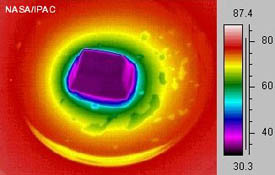|
Infrared radiation is produced by the motion of atoms and molecules in an object.
Only a few narrow bands of infrared light can be observed by ground-based
observatories. To view the rest of the infrared universe we need to use
space based observatories or high-flying aircraft. Since infrared can penetrate thick regions of dust in space,
these infrared observations are used to peer into star-forming regions and into the central areas of our galaxy. Cool stars and cold interstellar clouds which are invisible in optical light are also observed in the infrared.
Infrared is primarily heat radiation and special detectors cooled to
extremely low temperatures are needed for most infrared observations. Viewing objects through the infrared detectors can be used as a way to measure the heat radiated by an object. The higher the temperature, the more the atoms and molecules move and the more infrared they produce.
Even objects that we think of as being very cold, such as an ice cube, emit infrared. When an object is not quite hot enough to radiate visible light, it will emit most of its energy in the infrared. For example, hot charcoal may not give off light but it does emit infrared radiation, which we feel as heat.
Everything has some heat and puts out infrared light. In the infrared images shown below, different colors are used to represent different temperatures. You can find out which temperature a color represents by using the color-temperature scale show to the right of most of the images. The temperatures are in degrees Fahrenheit.
 
To the left is an infrared image of a metal cup holding a very hot drink. Notice the rings of color showing heat traveling from the liquid through the metal cup. You can see this in the metal spoon as well. To the right is an infrared image of a melting ice cube. Notice the rings of color showing how the melt water warms as it travels away from the cube. Although the ice cube is cold, it still puts out heat, as you can see by matching the color of the ice cube with its temperature. A very informative infrared site containing great information, pictures and videos is one sponsored by Caltech at http://coolcosmos.ipac.caltech.edu/.
|






